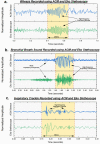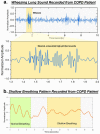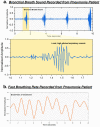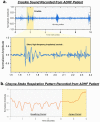Detection of pathological mechano-acoustic signatures using precision accelerometer contact microphones in patients with pulmonary disorders
- PMID: 34183695
- PMCID: PMC8238985
- DOI: 10.1038/s41598-021-92666-2
Detection of pathological mechano-acoustic signatures using precision accelerometer contact microphones in patients with pulmonary disorders
Abstract
Monitoring pathological mechano-acoustic signals emanating from the lungs is critical for timely and cost-effective healthcare delivery. Adventitious lung sounds including crackles, wheezes, rhonchi, bronchial breath sounds, stridor or pleural rub and abnormal breathing patterns function as essential clinical biomarkers for the early identification, accurate diagnosis and monitoring of pulmonary disorders. Here, we present a wearable sensor module comprising of a hermetically encapsulated, high precision accelerometer contact microphone (ACM) which enables both episodic and longitudinal assessment of lung sounds, breathing patterns and respiratory rates using a single integrated sensor. This enhanced ACM sensor leverages a nano-gap transduction mechanism to achieve high sensitivity to weak high frequency vibrations occurring on the surface of the skin due to underlying lung pathologies. The performance of the ACM sensor was compared to recordings from a state-of-art digital stethoscope, and the efficacy of the developed system is demonstrated by conducting an exploratory research study aimed at recording pathological mechano-acoustic signals from hospitalized patients with a chronic obstructive pulmonary disease (COPD) exacerbation, pneumonia, and acute decompensated heart failure. This unobtrusive wearable system can enable both episodic and longitudinal evaluation of lung sounds that allow for the early detection and/or ongoing monitoring of pulmonary disease.
Conflict of interest statement
P.G., and F.A. are the inventors of the technology being studied and the purpose of this project is to explore its commercialization. The terms of arrangement have been reviewed and approved by Georgia Tech in accordance with its conflict-of-interest policies. L.D.F. and H.W. declare no competing interests.
Figures






Similar articles
-
A MEMS seismometer respiratory monitor for work of breathing assessment and adventitious lung sounds detection via deep learning.Sci Rep. 2025 Mar 15;15(1):9015. doi: 10.1038/s41598-025-93011-7. Sci Rep. 2025. PMID: 40089574 Free PMC article.
-
Precision wearable accelerometer contact microphones for longitudinal monitoring of mechano-acoustic cardiopulmonary signals.NPJ Digit Med. 2020 Feb 12;3:19. doi: 10.1038/s41746-020-0225-7. eCollection 2020. NPJ Digit Med. 2020. PMID: 32128449 Free PMC article.
-
Computerized respiratory sounds: a comparison between patients with stable and exacerbated COPD.Clin Respir J. 2017 Sep;11(5):612-620. doi: 10.1111/crj.12392. Epub 2015 Oct 12. Clin Respir J. 2017. PMID: 26403859
-
Lung and Heart Sounds Analysis: State-of-the-Art and Future Trends.Crit Rev Biomed Eng. 2018;46(1):33-52. doi: 10.1615/CritRevBiomedEng.2018025112. Crit Rev Biomed Eng. 2018. PMID: 29717676 Review.
-
MEMS and ECM Sensor Technologies for Cardiorespiratory Sound Monitoring-A Comprehensive Review.Sensors (Basel). 2024 Oct 31;24(21):7036. doi: 10.3390/s24217036. Sensors (Basel). 2024. PMID: 39517931 Free PMC article. Review.
Cited by
-
Machine Learning for Automated Classification of Abnormal Lung Sounds Obtained from Public Databases: A Systematic Review.Bioengineering (Basel). 2023 Oct 2;10(10):1155. doi: 10.3390/bioengineering10101155. Bioengineering (Basel). 2023. PMID: 37892885 Free PMC article. Review.
-
Hybrid learning method based on feature clustering and scoring for enhanced COVID-19 breath analysis by an electronic nose.Artif Intell Med. 2022 Jul;129:102323. doi: 10.1016/j.artmed.2022.102323. Epub 2022 May 17. Artif Intell Med. 2022. PMID: 35659391 Free PMC article.
-
Audio-based digital biomarkers in diagnosing and managing respiratory diseases: a systematic review and bibliometric analysis.Eur Respir Rev. 2025 May 14;34(176):240246. doi: 10.1183/16000617.0246-2024. Print 2025 Apr. Eur Respir Rev. 2025. PMID: 40368428 Free PMC article.
-
A MEMS seismometer respiratory monitor for work of breathing assessment and adventitious lung sounds detection via deep learning.Sci Rep. 2025 Mar 15;15(1):9015. doi: 10.1038/s41598-025-93011-7. Sci Rep. 2025. PMID: 40089574 Free PMC article.
-
Diaphragm Design for an Electret Microphone Stethoscope.IEEE Sens J. 2025 Jul 15;25(14):26711-26722. doi: 10.1109/jsen.2025.3573907. Epub 2025 Jun 5. IEEE Sens J. 2025. PMID: 40837672 Free PMC article.
References
-
- European Respiratory Society. The Global Impact of Respiratory Disease- Second Edition. Forum of International Respiratory Societies. (2017).
-
- Strategy, G., The, F. O. R., Of, P., Obstructive, C. & Disease, P. From the Global Strategy for the Diagnosis, Management and Prevention of COPD, Global Initiative for Chronic Obstructive Lung Disease (GOLD) 2016. Gold Guidlines (2016).
Publication types
MeSH terms
LinkOut - more resources
Full Text Sources
Medical
Miscellaneous

